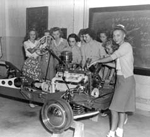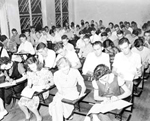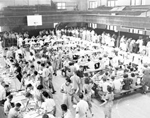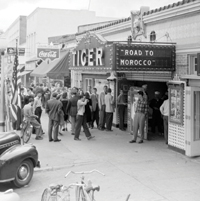|
A Centennial of Auburn Engineering:
|
||||||||||||||
 |
| flat head Ford demo in class |
The economic situation worsened and by April 1930 Knapp admitted, “Auburn didn’t have funds to meet the May 1 payroll.” However, he had already let contracts for the textile engineering and new shop buildings. They completed construction of the former in 1930, outfitted it in 1931, and with the help of the local industry, obtained needed equipment. They also opened the new shop building containing woodworking and sheet metal workshops.
Wilmore established an aeronautical option in mechanical engineering and announced plans to establish a curriculum in industrial engineering, which offered “suitable courses in business and economics . . . added to a sound basic engineering training [to] qualify men for positions in the management side of industry.”
 |
| Registration by hand |
In early 1932, API was about five months late in paying salaries, but despite the worsening depression, enrollment increased. The lack of funds for 1933 caused more concern as the legislature considered balancing the state budget by further cutting educational expenses. Knapp explained that if this occurred, he would have to cut salaries across the board. Then on July 28, 1932, he issued his valedictory report, which said, “to dismantle the work here at Auburn at the present time would be a crime.”
 |
| Long lines |
 |
| The
Road to Morocco begins at Tiger Theater |
During the 1934 academic year, API awarded the largest number of degrees it had ever granted, but enrollment during the fall semester of 1934 dropped to the lowest level since the start of the depression. Engineering enrollment remained at about 41 percent of the total student body, after peaking at 52 percent in 1926. However, the engineering freshman class in 1934 was large, which augured well for future growth. Auburn limped along paying less than half of faculty salaries and the typical faculty member lived on $67.50 per month, or about $1,100 in today’s inflation-adjusted dollars. Resignations increased and despite a shortage of teachers, they hired few replacements. Wilmore appointed Charles Hixon as temporary assistant dean of engineering since his duties as chair took up most of his time.
When Bibb Graves returned as governor in 1935, he appointed a presidential selection committee that picked Luther N. Duncan as president. Wilmore, 71 and obviously relieved to return to the School of Engineering, expressed his “genuine pleasure” with the new president, who named him to chair the institute’s executive council. By the spring of 1937, the college had recovered sufficiently to pay faculty and staff 90 percent of their salaries; in 1938, they were paid in full. Duncan called for renewed state support for the engineering school and its experiment station, as well as for the adoption of a cooperative engineering education plan. He also asked for an expansion of the graduate program by increasing the number of fellowships and the adoption of uniform regulations governing graduate education.
Engineering E-Mag is a service of the Samuel Ginn College of Engineering. This newsletter is distributed to alumni and friends throughout the year.
To read archived copies visit: http://www.eng.auburn.edu/.
To learn more about the Samuel Ginn College of Engineering, visit our Web site at:http://www.eng.auburn.edu/.
QUESTIONS about Engineering E-Mag may be directed to Michael Stone, Webmaster for the Samuel Ginn College of Engineering, at webmaster@eng.auburn.edu
Auburn University is an equal opportunity educational institution/employer.


